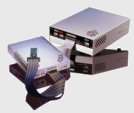Startup Group
The Hicom startup group was responsible for taking the compiled code, insuring the switch was properly configured with correct hardware levels, firmware revision levels, installing the software and getting everything working well enough that the code could be released for developer testing. This was a highly visible, high pressure bottleneck process requiring considerable on and off-hours communication and coordination with both local staff and staff at development centers in Europe and later California.

Intel In Circuit Emulators similar to the ones used in the startup group to step through 8086 assembly code.
Prior to receiving a new software build, members of the startup group (There were three of us) would contact counterparts in Munich, Germany and on occasion, Zurich, Switzerland and Vienna, Austria to confirm which hardware, firmware and European software patches should be included. At the time, a configuration management system wasn't available and things got done by communicating with counterparts. Compounding the challenge was that all documentation taken over from Germany was written in German.
Once the software was loaded onto the Hicom PBX, the process of starting up the switch began in full earnest. Typically, the switch would run briefly and then crash. The startup teams job was to then determine the source of the crash. Most of the time, a software problem was the culprit. We would identify where in the software the problem was and write 8086 assembly language patches to fix or bypass the offending code and continue starting the switch up. Eventually, we would get the switch up into it's idle state where the software could then be released for developer testing.
At this time, a means did not exist in the company to read code listings electronically. We would step through the i8086 assembly instructions using an Intel ICE unit and cross reference assembly readout on the ICE terminal with high level code on paper listings.
Since electronic browseable listings were not available, printing out an entire set of listings took several days on a high capacity industrial tractor feed printer and I seem to recall the cost of a complete print job being between $5 and $10 thousand dollars. Several hand carts were required to bring all the listings into the startup lab.
Most of the high level software was written in Germany, Austria and Switzerland and was commented in German. Trying to understand enough about the code to be able to write a temporary patch to either fix or bypass the problem was quite a challenge. Fortunately, one of the startup team members was an Austrian on temporary assignment and he provided German to English translations.

Frank Overstreet and colleagues after work in a Munich beer garden (Biergarten). Note my German-English dictionary on the table in front of me. Click image to enlarge.
After about 9 months, my Austrian colleague was scheduled to return home and a decision was made that I should travel to Munich, Germany for a few months in order to meet and work with team counterparts. I ended up staying in Munich about 6 months during which time I learned a lot about the architecture of the Hicom PBX, made excellent contacts with counterparts and considerably improved my German language skills. I ultimately took 3 or 4 semesters of German at nearby Florida Atlantic University.
Upon returning to Boca Raton, I became the defacto technical lead in the Hicom startup group and continued in this capacity for several more months until my manager (who also managed a development group) asked me to transfer into his software development group.




